Angel Wing Begonia, Rex Begonia, Tuberous Begonia, Wax Begonia, Hardy Begonia, Begonia grandis, Begonia boliviensis
Begonia plants are popular flowering plants with over 2,000 species and countless hybrids. They are native to subtropical and tropical regions and can be found growing in a variety of habitats, from rainforests to deserts. Begonias are known for their vibrant flowers, which come in a range of colors and sizes, as well as their attractive foliage.
Overall, begonias are a beautiful and rewarding plant to grow, with a wide range of varieties and growing options to choose from. With proper care and attention, they can thrive and produce abundant flowers and foliage, adding color and interest to any garden or indoor space.
Begonia can be divided into various types based on their growth habit and leaf characteristics. Here are some of the main types of Begonia and their characteristics:
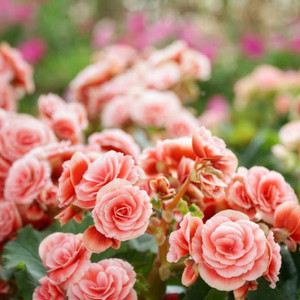 |
Tuberous BegoniaTuberous begonias have large, tuberous roots that store water and nutrients, allowing the plant to survive in various conditions. They can be upright or trailing and produce large, single, or double flowers in shades of red, pink, orange, yellow, and white. The green or burgundy leaves are either round or heart-shaped. Where to plant: These plants are commonly grown in containers and hanging baskets, and they thrive in areas with filtered sunlight and well-draining soil. They prefer partial shade and well-draining soil. When to plant: It’s best to plant the tubers indoors in late winter or early spring and then transplant them outside after the threat of frost has passed in the spring. |
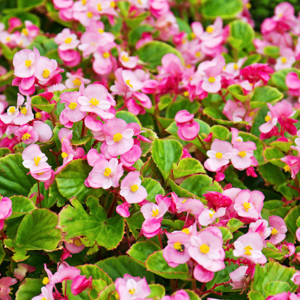 |
Wax Begonia (Begonia x semperflorens-cultorum)The plant: Wax begonias are small, compact plants with shiny and waxy, dark green or reddish-brown leaves. They typically grow 6-12 inches tall and wide (15-30 cm). They bloom prolifically from spring through fall in shades of pink, red, white, and sometimes yellow. Where to plant: They are versatile plants that can be used in various ways, including as edging plants, ground covers, or in containers. They prefer partial shade but can tolerate full sun if the soil is kept moist. When to plant: These are typically planted outdoors after the last frost date in spring or early summer. |
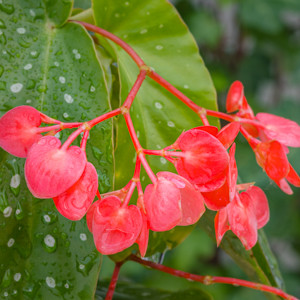 |
Angel Wing Begonia (Begonia coccinea)Angel Wing Begonias, or cane begonias, are prized for their distinctive wing-shaped leaves and showy blooms. The dark green leaves are speckled, and the flowers are typically pink, red, or white. Angel Wing Begonias are easy to care for and tolerate lower light conditions. They also have air-purifying qualities, helping to remove toxins from indoor spaces. Where to plant: These plants are often grown as houseplants or in protected outdoor locations. They prefer bright, indirect light and well-draining soil. When to plant: These can be planted outdoors after the last frost date, but they prefer warm temperatures and may not thrive in cooler climates. |
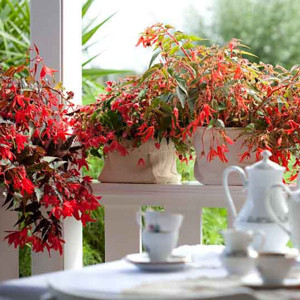 |
Begonia boliviensis (Begonia boliviensis)Begonia boliviensis, also known as the Bolivian begonia, is loved for its striking, pendulous flowers that are bright red-orange in color and hang from the tips of long, trailing stems. The plant has dark green, glossy leaves that provide a nice contrast to the vibrant flowers. Where to plant: It is a popular choice for hanging baskets and container gardens. It prefers well-draining soil and partial shade. When to plant: These are typically planted in the spring after the last frost date. They prefer warm temperatures and well-drained soil. |
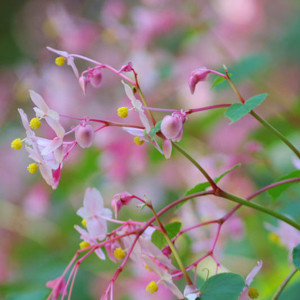 |
Hardy Begonia (Begonia grandis)Begonia grandis, commonly known as hardy begonia, are herbaceous perennial plants that can grow up to 3 feet tall (90 cm) and 2 feet wide (60 cm). The wing-shaped leaves are adorned with red veining and colorful undersides. The plant produces pink or white flowers in late summer or early fall that rise above the foliage on long, slender stems. Where to plant: Begonia grandis is a popular plant for shade gardens and woodland areas and grows best in rich, moist soils in partial shade. When to plant: These can be planted in the spring or fall in a location that receives partial shade. They can tolerate cooler temperatures than other begonia types. |
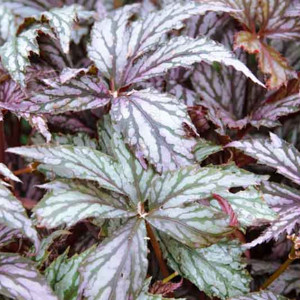 |
Rex Begonia (Begonia rex)These are prized for their stunning foliage, which features an array of colors, patterns, and textures. They are grown primarily for their foliage, although they do produce small, insignificant flowers. Where to plant: They grow best indoors or in containers placed in partial shade. When to plant: These are typically grown as indoor houseplants and can be planted at any time of year. They prefer warm, humid environments and well-drained soil. |
| Hardiness |
7 - 11 |
|---|---|
| Plant Type | Annuals, Perennials |
| Genus | Begonia |
| Exposure | Partial Sun |
| Season of Interest |
Spring (Late) Summer (Early, Mid, Late) Fall |
| Maintenance | Low |
| Water Needs | Average |
| Soil Type | Loam, Sand |
| Soil pH | Acid, Neutral |
| Soil Drainage | Moist but Well-Drained, Well-Drained |
| Characteristics | Showy |
| Tolerance | Deer |
| Landscaping Ideas | Beds And Borders, Hanging Baskets, Patio And Containers |
| Garden Styles | City and Courtyard, Informal and Cottage |
Jacqui Martin, Shutterstock
| Hardiness |
7 - 11 |
|---|---|
| Plant Type | Annuals, Perennials |
| Genus | Begonia |
| Exposure | Partial Sun |
| Season of Interest |
Spring (Late) Summer (Early, Mid, Late) Fall |
| Maintenance | Low |
| Water Needs | Average |
| Soil Type | Loam, Sand |
| Soil pH | Acid, Neutral |
| Soil Drainage | Moist but Well-Drained, Well-Drained |
| Characteristics | Showy |
| Tolerance | Deer |
| Landscaping Ideas | Beds And Borders, Hanging Baskets, Patio And Containers |
| Garden Styles | City and Courtyard, Informal and Cottage |
Create a membership account to save your garden designs and to view them on any device.
Becoming a contributing member of Gardenia is easy and can be done in just a few minutes. If you provide us with your name, email address and the payment of a modest $25 annual membership fee, you will become a full member, enabling you to design and save up to 25 of your garden design ideas.
Join now and start creating your dream garden!
Create a membership account to save your garden designs and to view them on any device.
Becoming a contributing member of Gardenia is easy and can be done in just a few minutes. If you provide us with your name, email address and the payment of a modest $25 annual membership fee, you will become a full member, enabling you to design and save up to 25 of your garden design ideas.
Join now and start creating your dream garden!